|
Printables |
PowerPoints |
Online exercises |
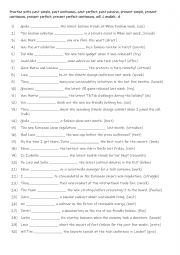
|
B1+-B2 Practise with past simple, past continuous, past perfect, past passive, present simple, present continuous, present perfect, present perfect continuous, will & modals 4
Learning these tenses helps students communicate clearly and accurately in different contexts. The past tenses describe completed actions, ongoing events, or actions that happened before another past event. The present tenses express routines, ongoing actions, and experiences linked to the present. The future tense (will) is used for predictions an...
Level: intermediate
Age: 10-100
Type:
Downloads: 118
|
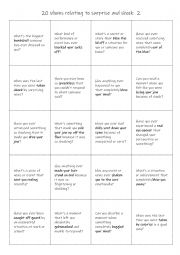
|
B1+-C1 20 Idioms relating to surprise and shock 2
This is a speaking reinforcement activity to supplement the other worksheet I uploaded on 3/2/2025. Students working in pairs or small groups can either ask each other the questions or answer the question themselves.
Level: intermediate
Age: 11-100
Type:
Downloads: 118
|
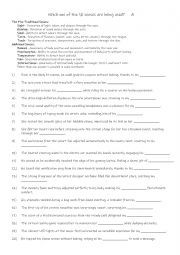
|
A2-B1 Which one of the 10 senses are being used 4
Learning about the traditional and additional senses helps students understand how humans perceive and interact with the world. It highlights how senses like sight, hearing, smell, taste, and touch, along with balance, proprioception, and temperature, provide essential information for navigating and responding to our environment. This knowledge is ...
Level: elementary
Age: 8-100
Type:
Downloads: 118
|
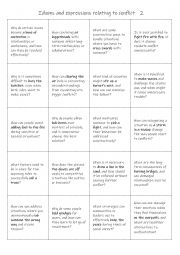
|
B1+-C1 Idioms and expressions relating to conflict 2
This is a speaking reinforcement activity to supplement the other worksheet I uploaded on 29/1/2025. Students working in pairs or small groups can either ask each other the questions or answer the question themselves.
Level: intermediate
Age: 12-100
Type:
Downloads: 118
|
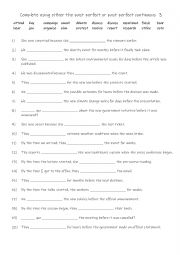
|
A2-B1 Complete using either the past perfect or past perfect continuous 3
First, students need to familiarise themselves with the 2 tenses and their use. Then they read the sentences to see which tense is needed to complete the sentence. Each tense is used 10 times! Answers on page 2.
Level: elementary
Age: 10-100
Type:
Downloads: 118
|
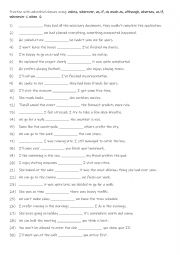
|
A2+-B1 10 Adverbial clauses 6
Learning adverbial clauses using words like unless, wherever, as, if, as much as, although, whereas, as if, whenever and when helps students express complex relationships between ideas, such as condition, time, contrast, and manner. First, students need to familiarise themselves with the 10 adverbial clauses and their use. Then they read the senten...
Level: elementary
Age: 9-100
Type:
Downloads: 118
|
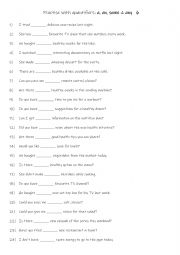
|
A1-A2 Practise with quantifiers a , an , some & any 6
Mastering these basics is essential for both everyday communication and more advanced language use, as these quantifiers are frequently used in real-life scenarios like offering, requesting, or describing items. First, students need to familiarise themselves with 4 quantifiers and check their meaning and use. Then they read the sentences to see whi...
Level: elementary
Age: 7-100
Type:
Downloads: 118
|

|
A2+-B1 Past participle clauses 4
Students complete the gap-fill with the correct word. Answers on page 2.
Level: elementary
Age: 10-100
Type:
Downloads: 118
|
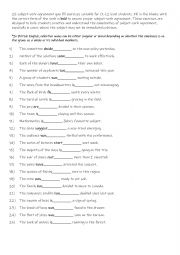
|
25 subject-verb agreement gap fill exercises suitable for C1-C2
25 subject-verb agreement gap fill exercises suitable for C1-C2 level students. Fill in the blanks with the correct form of the verb in bold to ensure proper subject-verb agreement. These exercises are designed to help students practice and understand the complexities of subject-verb agreement, especially in cases where the subject may not be immed...
Level: advanced
Age: 14-100
Type:
Downloads: 117
|
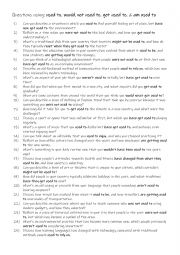
|
Questions using: used to, would, not used to, get used to, & am used to
Students in pairs or small groups use the grammar point relating to adjusting to situations both past and present to develop more fluency and confidence when using them. Not suitable for low intermediate levels!
Level: advanced
Age: 15-100
Type:
Downloads: 117
|
|
|
|
|












